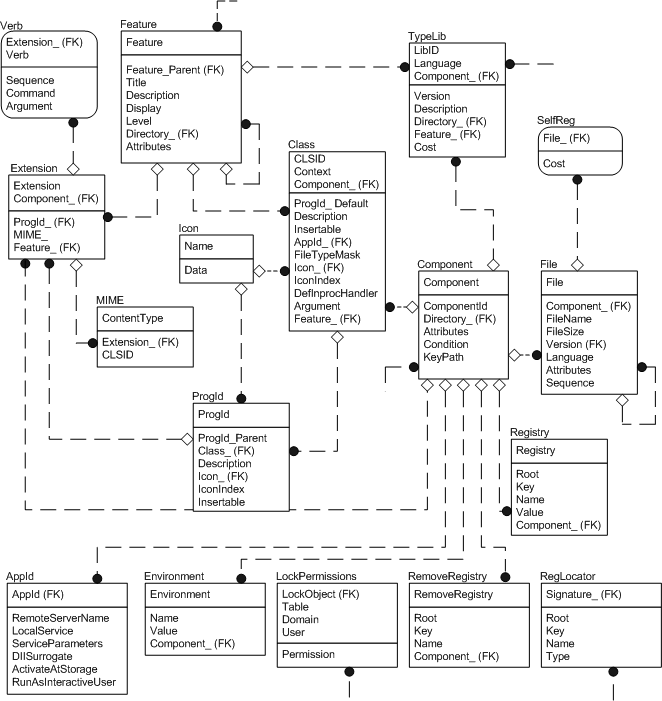Registertabellgrupp

Mer information om det här diagrammet finns i förklaringen entitetsrelationsdiagram.
Installationsprogrammet har specifika tabeller för de olika typerna av registerposter. När du fyller i registertabellgruppen är det viktigt att försöka minimera antalet poster som placeras i tabellen Registry och maximera användningen av andra, specifika registertabeller. Det beror på att installationsprogrammet inte kan skilja mellan olika typer av registerposter i registertabellen och inte kan använda den interna logik som krävs för att dra full nytta av alla installationsfunktioner, till exempel annonsering. Redigering av COM- och shell-relaterade registerposter på det här sättet ger också en mer logisk organisation och kan hjälpa till att minimera felaktig registrering av COM-serverinformation.
Bilden visar registerpostgruppen med tabeller samt tabellen Component, Feature tableoch File table. Även om de senare inte är direkt involverade i att fylla i registret inkluderas de i figuren eftersom de är viktiga för logiken i registerinmatningsgruppen.
Registerpostgruppen innehåller följande tabeller med specifika registerposter.
- Tabellen -tillägg innehåller alla filnamnstillägg som programmet använder tillsammans med tillhörande funktioner och komponenter.
- Tabellen Verb associerar kommandoverbinformation med filnamnstilläggen som anges i tabellen -tillägg. Detta ger en indirekt länk mellan verb- och funktionstabellen som behövs för funktionsannonsering.
- Tabellen TypeLib innehåller information som installationsprogrammet placerar i registret för registrering av typbibliotek. Typbiblioteksposter skrivs inte vid tidpunkten för annonsen. Installationsprogrammet skriver posterna för typbiblioteket när de komponenter som är associerade med biblioteket installeras.
- Den MIME-tabellen associerar en MIME-kontexttyp med ett CLSID eller ett filnamnstillägg. Detta ger en sökväg mellan MIME och funktionstabellen som behövs för funktionsannonsering.
- Tabellen SelfReg innehåller information som behövs för självregistrering av moduler. Självregistrering tillhandahålls endast av installationsprogrammet för bakåtkompatibilitet och det rekommenderas inte som en metod för att fylla i registret, men om det finns några moduler i ditt program som måste registrera sig använder du SelfReg-tabellen.
- Tabellen Class används för att registrera klass-ID:er och annan information för COM-objekt. Den här tabellen innehåller COM-serverrelaterad information som måste genereras som en del av produktannonsen.
- Tabellen ProgId associerar program-ID:t med klass-ID:t.
- Tabellen AppId används för att registrera vanliga säkerhets- och konfigurationsinställningar för DCOM-objekt.
- Tabellen Miljö används för att ange värden för miljövariabler, och i Windows 2000 skriver tabellen Miljö även till registret.
- Tabellen Registry innehåller all annan information som programmet måste lägga till i systemregistret. Detta skulle omfatta standardinställningar, användarinformation eller data eller COM-registrering som inte stöds av tabellerna ovan.
- Tabellen RemoveRegistry innehåller den registerinformation som programmet behöver ta bort från systemregistret vid installationen.